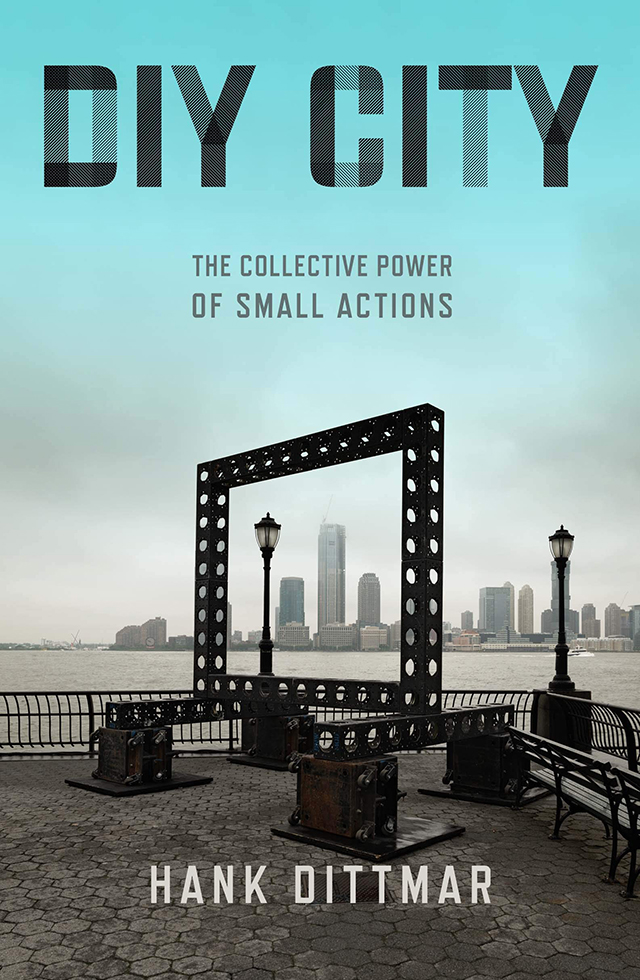DIY City
DIY City: The Collective Power of Small ActionsHank DittmarIsland Press, June 2020Paperback | 5-1/4 x 8 inches | 166 pages | 25 illustrations | English | ISBN: 978-1642830521 | $30.00PUBLISHER'S DESCRIPTION: Some utopian plans have shaped our cities —from England’s New Towns and Garden Cities to the Haussmann plan for Paris and the L’Enfant plan for Washington, DC. But these grand plans are the exception, and seldom turn out as envisioned by the utopian planner. Inviting city neighborhoods are more often works of improvisation on a small scale. This type of bottom-up development gives cities both their character and the ability to respond to sudden change. Hank Dittmar, urban planner, friend of artists and creatives, sometime rancher, “high priest of town planning” to the Prince of Wales, believed in letting small things happen. Dittmar concluded that big plans were often the problem. Looking at the global cities of the world, he saw a crisis of success, with gentrification and global capital driving up home prices in some cities, while others decayed for lack of investment. In DIY City, Dittmar explains why individual initiative, small-scale business, and small development matter, using lively stories from his own experience and examples from recent history, such as the revival of Camden Lock in London and the nascent rebirth of Detroit. DIY City, Dittmar’s last original work, captures the lessons he learned throughout the course of his varied career—from transit-oriented development to Lean Urbanism—that can be replicated to create cities where people can flourish. Hank Dittmar (1956–2018) was the founding principal of Hank Dittmar Associates, an international urban planning firm. Before that, he was chief executive of The Prince’s Foundation for Building Community, leading the foundation in contributing to the design of our built environment at practical and policy levels both in the UK and internationally. REFERRAL LINKS: dDAB COMMENTARY: I'll admit that I fall prey to first impressions often, regardless of how many times I try not to. In the case of DIY City by the late Hank Dittmar, that first impression came during what I do every time I tackle a new book: flipping through it quickly to look at the pictures. Standing out was one of the color photos in the middle of the book (first spread below), the one showing Dittmar with Prince Charles as the pair was "considering a plan with graduate fellows" in 2010. Back then, Dittmar was chief executive of the Prince's Foundation for Building Community, which (now simply The Prince's Foundation) aims to realize "HRH The Prince of Wales' vision of creating harmonious communities." For me — someone who is aligned with the Prince's embrace of walkable, sustainable communities but detests the style wars he was fond of starting in favor of neotraditional architecture — this was a red flag. But not wanting one image to sway me, I delved into the book, starting with a chapter where the apparent antithesis of Prince Charles was found. At the beginning of chapter five, "Slack Is a Good Thing," is a still from Slacker, the 1990 film debut of Richard Linklater. Featuring a meandering story following a cast of quirky characters across Austin, Texas, the low-budget film embraces a point of view very much at odds with creations like Poundbury. But to Dittmar, who became friends with Linklater through Dittmar's wife and who includes snippets of conversations with the filmmaker in the chapter, Slacker was not about being lazy, it was not about lounging around at home drinking beer instead of working. It was about taking the time between college and career to explore creativity and expression; it was about being self-motivated; it was about working, but not the kind of work that related to market forces. The urban equivalent of Slacker — or "slack" — are the empty lofts where young artists can live and work because they're cheap, for instance, as well as a city willing to foster such scenes. Dittmar's idea of "slack," though, is very close to Richard Florida's "creative class," meaning that we've gone from Prince Charles to gentrification: after the artists turn a formerly industrial area into a cool place that is relatively safe, young professionals move in, developers follow, and it's just a matter of time before the area is home to luxury brands and class A office space. Dittmar was well aware of that slippery slope, hence his embrace of the small — the DIY — within the context of top-down planning and development. Dittmar favored "providing people with access to tools and people then using those tools to exploit gaps in a system that is engineered for large organizations and large numbers." Yet just as Dittmar acknowledges the inequality that persists in cities, DIY has its own inequalities. Which citizens are able to band together to create a place, for instance, that their local government fails to provide? More often than not, it's the ones who can


Hank Dittmar
Island Press, June 2020
Paperback | 5-1/4 x 8 inches | 166 pages | 25 illustrations | English | ISBN: 978-1642830521 | $30.00
PUBLISHER'S DESCRIPTION:
REFERRAL LINKS:
SPREADS:






